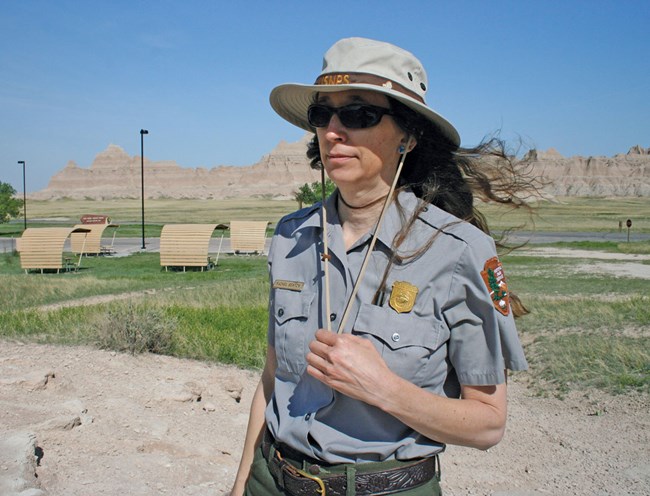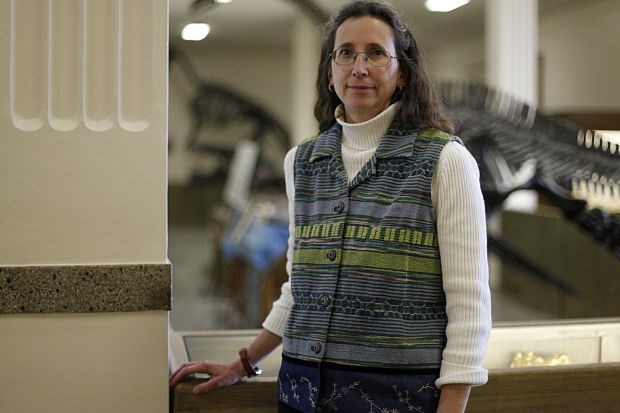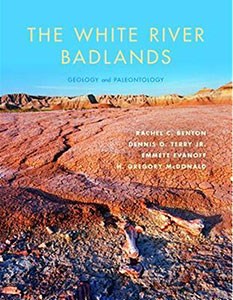Part of a series of articles titled Park Paleontology News - Vol. 11, No. 1, Spring 2019.
Article
NPS Paleontologist Rachel Benton retires from Badlands National Park

What is your educational background?
I have a Bachelor of Science degree was in geology from Denison (Ohio) University (1983). My Master of Science is in vertebrate paleontology from the South Dakota School of Mines and Technology (1991) and my PhD is in geology from the University of Iowa (1999).
How did you get your start with the NPS?
My first position with the National Park Service was at Delaware Water Gap in 1984, where I worked as a volunteer. I later obtained a seasonal position there in 1985 and 1986, working primarily in interpretation and resource management. I filled the niche of park geologist, leading many geology interpretive programs. I also volunteered at Big Bend National Park in 1986 in interpretation. Once I moved to South Dakota for graduate work, I worked as a seasonal at Wind Cave National Park and at Badlands National Park. At Wind Cave National Park, I worked for Rich Klukas on a taphonomy project and at Badlands, I was a museum technician. My first permanent job was at Fossil Butte National Monument where I was a Museum Specialist (1991-1993). At Badlands, I started as the Park Paleontologist in 1994. I retired from Badlands National Park in late 2018.
Are you able to share some of the highlights about your position at Fossil Butte NM?
- I co-managed, with Ann Elder, the Third Conference on Fossil Resources during 1992, in Kemmerer, Wyoming
- I documented, transferred and set up the Badlands National Park museum collections in their present location
- With the help of Ann Elder, I set up the Badlands National Park fossil preparation demonstration program
- I developed the first National Environmental Protection Act (NEPA) review process for fossil resources at FOBU

Photo courtesy of Rapid City Journal
What are some of the highlights during your position at Badlands National Park?
I began work as park paleontologist at Badlands National Park in 1994. I basically hit the ground running. I felt I had to make up for the last 50 years because the park had never hired a permanent park paleontologist, only several seasonal paleontologists. I worked with every division within the park. I developed a paleontological NEPA compliance program with the maintenance division. I worked on paleo-law-enforcement cases with the rangers. I assisted with interpretive programs with the Resource Education Program. The Pig Dig was in full swing having been discovered in 1993. It definitely needed someone from the Park Service to represent the program and to partner with the South Dakota School of Mines.
The Pig Dig had hundreds of very dedicated volunteers, students, faculty and seasonal employees. I also coordinated six years of paleontological surveys where we partnered with the School of Mines, Temple University and the University of Northern Colorado at Greeley. Thank you, Carrie Herbel, Dennis Terry and Emmett Evanoff. We also developed the Saber Site next to the Ben Reifel Visitor Center, and from the Saber Site, the park fossil preparation lab was created. Over the years, we were fortunate to have some of the most talented fossil preparators work at Badlands National Park. I was also very blessed to have two talented paleontologists, Ellen Starck and Wayne Thompson, working in the paleontology program as well. Without them, many projects would have never gotten off the ground. They are in charge now. Hopefully my replacement will be hired in the coming months. The next project I left behind is the survey of the Sharps Formation. That should be up and running during the summer of 2019.

Are you able to describe your book, The White River Badlands?
The goal of The White River Badlands: Geology and Paleontology was to build on the foundation of The White River Badlands written in 1920 by Cleophas C. O’Harra. The book was definitely a team effort, involving not only the four authors but many researchers and enthusiasts who love and want to protect the White River Badlands. The authors summarize the research conducted by many geologists and paleontologists that took place over the decades after O’Harra’s contribution. The book reaches out to the many enthusiasts, both amateur and professional with an interest in the geology and paleontology of the Big Badlands. The main focuses of the book are: the history of science as it relates to the Badlands; the specific geology and paleontology; and paleontological resource management as it relates to Badlands National Park.
Where will you retire and do you have any plans?
I presently live in Rapid City, South Dakota and I volunteer at the South Dakota School of Mines and Technology and at Badlands National Park. I am also involved in several philanthropic endeavors relating to university research programs, Public Broadcasting and the National Park Service.
Last updated: July 28, 2020
